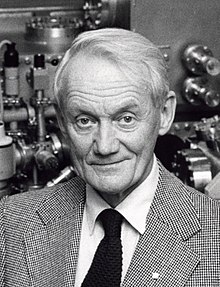Kai Siegbahn
Kai Siegbahn | |
|---|---|
 Siegbahn in 1981 | |
| Born | 20 April 1918 Lund, Sweden |
| Died | 20 July 2007 (aged 89) Ängelholm, Sweden |
| Alma mater | University of Stockholm |
| Known for | X-ray photoemission spectroscopy |
| Awards | Nobel Prize in Physics (1981) Björkén Prize (1955, 1977) |
| Scientific career | |
| Fields | Physics |
| Institutions | University of Stockholm University of Uppsala |
Kai Manne Börje Siegbahn (20 April 1918 – 20 July 2007) was a Swedish physicist who shared the 1981 Nobel Prize in Physics.[1]
Biography
[edit]Siegbahn was born in Lund, Sweden, son of Manne Siegbahn the 1924 physics Nobel Prize winner. Siegbahn earned his doctorate at the University of Stockholm in 1944. He was professor at the Royal Institute of Technology 1951–1954, and then professor of experimental physics at Uppsala University 1954–1984, which was the same chair his father had held.[2] He shared the 1981 Nobel Prize in Physics with Nicolaas Bloembergen and Arthur Schawlow. Siegbahn received half the prize "for his contribution to the development of high-resolution electron spectroscopy" while Bloembergen and Schawlow received one quarter each "for their contribution to the development of laser spectroscopy".[3]
Siegbahn referred to his technique as Electron Spectroscopy for Chemical Analysis (ESCA); it is now usually known as X-ray photoelectron spectroscopy (XPS). In 1967 he published a book, ESCA; atomic, molecular and solid state structure studied by means of electron spectroscopy.[4]
He was a member of several academies and societies, including the Royal Swedish Academy of Sciences, and was president of the International Union of Pure and Applied Physics from 1981 to 1984.[5]
Siegbahn married Anna Brita Rhedin in 1944. The couple had three sons (two physicists and a biochemist).[5][6]
Siegbahn died on 20 July 2007 at the age of 89.[1] At the time of his death he was still active as a scientist at the Ångström Laboratory at Uppsala University.[6]
Awards
[edit]As well as a share of the 1981 Nobel Prize in Physics, Siegbahn won the following awards:[5]
- 1945 Lindblom Prize
- 1955, 1977 Björkén Prize
- 1962 Celsius Medal
- 1971 Sixten Heyman Award, University of Gothenburg
- 1973 Harrison Howe Award, Rochester
- 1975 Maurice F. Hasler Award, Cleveland
- 1976 Charles Frederick Chandler Medal, Columbia University, New York
- 1977 Torbern Bergman Medal
- 1982 Pittsburgh Award of Spectroscopy
References
[edit]- ^ a b Jeremy Pearce (7 August 2007). "Kai Siegbahn, Swedish Physicist, Dies at 89". The New York Times.
- ^ Hagstrom, Stig B. (November 2007). "Obituary: Kai Manne Börje Siegbahn". Physics Today. 60 (11): 74–75. doi:10.1063/1.2812132.
- ^ "The Nobel Prize in Physics 1981". Nobel Foundation. Retrieved 27 September 2023.
- ^ "Kai Siegbahn - Nobel lecture: Electron Spectroscopy for Atoms, Molecules and Condensed Matter" (PDF). Nobel Foundation. 8 December 1981.
- ^ a b c "Kai Siegbahn - Curriculum Vitae". Nobel Foundation (From Nobel Lectures, Physics 1981-1990, Editor-in-Charge Tore Frängsmyr, Editor Gösta Ekspong, World Scientific Publishing Co., Singapore, 1993). Retrieved 14 September 2023.
- ^ a b Magdolna Hargittai (January 2022). "Kai M. Siegbahn (1918‒2007): a pioneer in high-resolution electron spectroscopy". Structural Chemistry. 33: 307–310. doi:10.1007/s11224-021-01865-0.
External links
[edit] Media related to Kai Siegbahn at Wikimedia Commons
Media related to Kai Siegbahn at Wikimedia Commons- Kai Siegbahn on Nobelprize.org
- 1918 births
- 2007 deaths
- Experimental physicists
- Nobel laureates in Physics
- Swedish physicists
- Stockholm University alumni
- Academic staff of the KTH Royal Institute of Technology
- People from Lund
- Members of the Pontifical Academy of Sciences
- Foreign associates of the National Academy of Sciences
- Foreign members of the Russian Academy of Sciences
- Members of the Norwegian Academy of Science and Letters
- Swedish Nobel laureates
- Academic staff of Uppsala University
- Spectroscopists
- Burials at Uppsala old cemetery
- Presidents of the International Union of Pure and Applied Physics
- Members of the Royal Swedish Academy of Sciences

